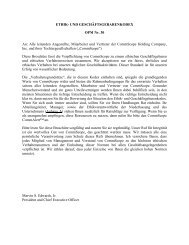Broadband Applications & Construction Manual - Public - CommScope
Broadband Applications & Construction Manual - Public - CommScope
Broadband Applications & Construction Manual - Public - CommScope
Create successful ePaper yourself
Turn your PDF publications into a flip-book with our unique Google optimized e-Paper software.
9.3 Residential Interior Cabling<br />
Cutting Outlet Holes<br />
Locating and Cutting Outlet Holes<br />
Once outlet locations are determined, cut the holes as required. Carefully check the area for any possible obstructions,<br />
such as wall studs, plumbing or electrical wires. Be aware that obstructions like windows or interior<br />
openings like kitchen passthroughs may cause problems with dropping cables from above. Pocket doors are another<br />
concern; make sure the planned outlet is outside of their open range. Keep an eye open for creative routes<br />
to hide cable, such as running within closets.<br />
Once you’ve settled on the precise locations, prepare to cut the holes<br />
(1) Mark the Location<br />
A communications outlet consists of the mounting bracket, the feet (which hold the bracket in the wall) and the<br />
faceplate. Using the mounting bracket as the template, trace a cutting pattern on the drywall, making sure there<br />
are no studs behind it. Match the orientation (vertical or horizontal) with the other outlets in the room and make<br />
sure your planned cut is level.<br />
(2) Cut the Opening<br />
Using a drywall knife, utility knife or saw, cut the opening. Do<br />
not install the bracket yet; the metal edges may damage the<br />
cable during pulling and installation.<br />
(3) Run the Cable<br />
Once the cable has been run, you may install the bracket and<br />
terminate the cable (see page 9.12/Trim out and finish).<br />
Other Wall Surfaces<br />
Older homes may have plaster and lathe walls that will require<br />
a small rotary saw, or a cutout tool to cleanly penetrate and cut. Masonry walls will require a surface-mounted<br />
box screwed into the brick and a cable raceway to hide the cable.
















